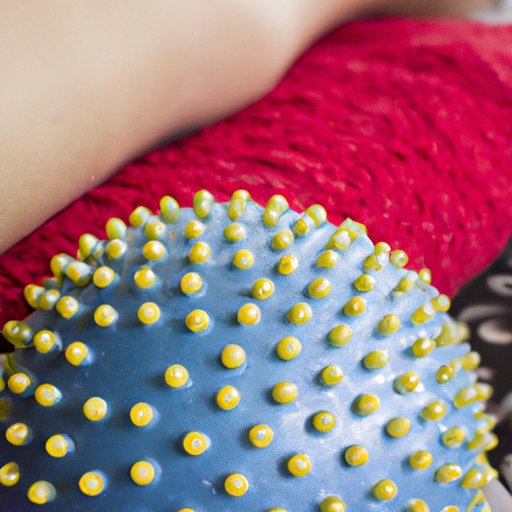Introduction
Buttock pain can be caused by a variety of factors, such as muscle strain, sciatica, and nerve damage. It can range from mild discomfort to severe pain that makes it difficult to sit or walk. Fortunately, there are a number of treatments available that can help alleviate the pain. Here is an overview of eight effective treatments for buttock pain.

Apply Ice or Heat Therapy
Applying cold or hot therapy to the affected area can help reduce inflammation and provide relief from pain. Cold therapy can help numb the area and reduce swelling, while heat therapy can help relax tight muscles and improve circulation.
According to a study published in the journal Pain Management Nursing, cold and hot therapy can be beneficial for patients with chronic pain. The study found that both hot and cold therapies were effective in reducing pain intensity and improving functional ability.
To apply cold or hot therapy, you can use a cold or hot pack or take a warm or cold bath. Make sure to wrap the cold or hot pack in a towel before applying it to the affected area. Leave the pack on for no more than 15 minutes at a time, and allow the skin to return to its normal temperature before reapplying.

Perform Gentle Stretches and Exercises
Gentle stretching and exercises can help strengthen the muscles in the buttocks and reduce pain. According to a study published in the journal Physical Therapy, performing specific stretching and strengthening exercises can help improve the symptoms of buttock pain.
Stretching exercises such as hip flexor stretches, gluteal stretches, and hamstring stretches can help loosen tight muscles and reduce pain. Strengthening exercises such as squats, bridges, and lateral leg raises can help build strength in the buttocks and reduce pain.
Take Over-the-Counter Pain Medication
Taking over-the-counter pain medications such as ibuprofen or acetaminophen can help reduce inflammation and relieve pain. Make sure to follow the instructions on the label and do not take more than the recommended dose.
It is also important to talk to your doctor before taking any over-the-counter medications, as they may interact with other medications you are taking or have contraindications for certain medical conditions.
Get a Massage
Getting a massage can help relieve tension in the muscles of the buttocks and reduce pain. According to a study published in the journal Complementary Therapies in Clinical Practice, massage therapy can be beneficial for people with chronic lower back pain.
Massage therapists typically use a combination of kneading, stroking, and pressing techniques to target the affected areas. The therapist will also use oils or lotions to help reduce friction and make it easier to move the skin and underlying muscles.
Use a Foam Roller
Using a foam roller can help target specific areas of the buttocks and reduce pain. A foam roller is a cylindrical piece of foam that can be used to roll out tight muscles and release tension. It can be used to target the glutes, hips, and hamstrings.
When using a foam roller, make sure to start slowly and gradually increase the pressure. Apply the foam roller directly to the affected area and roll in a slow and controlled motion for 10 to 15 seconds. You can also use the foam roller to perform stretching exercises such as hip flexor stretches and hamstring stretches.
Try Acupuncture
Acupuncture is an ancient Chinese practice that involves inserting thin needles into specific points on the body. According to a study published in the journal Evidence-Based Complementary and Alternative Medicine, acupuncture can be beneficial for patients with chronic lower back pain.
During an acupuncture session, the practitioner will insert needles into specific points on the body. These needles are then stimulated with either heat or electricity to stimulate the flow of energy in the body. The practitioner may also use other techniques such as cupping and moxibustion to further stimulate the affected area.
Use a Buttock Support Cushion
Using a buttock support cushion can help reduce the pressure on the buttocks and provide relief from pain. These cushions are designed to provide support to the buttocks and keep them properly aligned when sitting for long periods of time.
When choosing a cushion, make sure to select one that is firm enough to provide support but still comfortable. You should also make sure that the cushion is made of breathable material to prevent moisture buildup.
Conclusion
Buttock pain can be caused by a variety of factors, including muscle strain and nerve damage. Fortunately, there are a number of treatments available that can help relieve the pain. Applying ice or heat therapy, performing gentle stretches and exercises, taking over-the-counter pain medication, getting a massage, using a foam roller, trying acupuncture, and using a buttock support cushion can all be effective treatments for buttock pain.
If your pain persists or worsens, make sure to speak with your doctor. They can recommend additional treatments or refer you to a specialist if necessary.
In conclusion, there are many treatments available for buttock pain. From applying cold or hot therapy to performing gentle exercises and getting a massage, there are a variety of ways to relieve the pain. Be sure to talk to your doctor before beginning any new treatment.
(Note: Is this article not meeting your expectations? Do you have knowledge or insights to share? Unlock new opportunities and expand your reach by joining our authors team. Click Registration to join us and share your expertise with our readers.)
